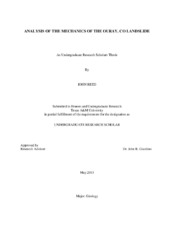| dc.description.abstract | Mountain areas are prime locations for mass movement activity, as a result of their steep slopes and large amount of local relief. As a rapid mass movement phenomena, landslides are responsible for a considerable numbers of deaths around the world each year. Thus, mitigation plans, such as the “Multi-Hazard Mitigation Plan” published by the County of Ouray, CO, have been developed to identify the spatial and temporal characteristic of potential hazards to minimize impact on humans and real property. The Ouray area has numerous landslides that have been mapped, and a large-sized landslide in this region of the San Juan Mountains is locally referred to as the Amphitheater Landslide. Although the area has been mapped as a landslide, the exact size, extent, and cause of the landslide have not been determined because the complex geological history of the region masks much of the landslide. Identification of the landslide extent and the cause are fundamental to establishing potential risks associated with this landslide. The town of Ouray, which is situated on the floor of a glaciated valley down slope from the scarp of the landslide is situated aside the toe of the landslide. The landslide was mapped using high-resolution, color aerial photography and geomorphic mapping. The landslide is 81,834,372 ft2, composed of San Juan tuff mixed with glacial debris and underlain by the Molas Formation (i.e., weak shale beds). Preliminary examination suggested that the exposed Molas shale experienced strain and saturation during the last interglacial period resulting in decreased shear strength. The valley slopes are draped with moraines, which were emplaced in contact with the glaciers, (i.e., ice-contact), which resulted in slopes that exceeded the angle of repose for the material. As the climate warmed and the glaciers melted, the support that was provided by the ice contact melted and the resulting slopes are today in disequilibrium and prone to failure. This study provides an assessment of the mechanics of movement of the Amphitheater landslide, which can be used to help minimize similar potential hazards. | en |


